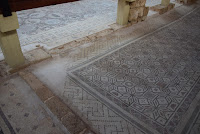(...)















The moment we walked into the 2,000 square metre house with its floor covered in mosaics we could admire from wooden platforms we came across some pebble mosaic ones dating fromthe late 4th and early 3rd centuries B.C. One of them depicted Scylla, the mythical sea-monster, who is part woman part dog. She is illustrated holding a ship mast and a trident.

We moved faster than it would be expected because it was getting darker and the outside light didn't provide the best conditions to admire the mosaics, let alone photograph them. I felt then that we might have spent the whole day here and still have little details to look at.

One of the many interesting mosaics dating from the late 2nd and early 3rd centuries B.C consisted of nine small panels with anthropomorphic representations with some unidentified figures, though in every corner there were the four seasons depicted.


We soon came across a few "Vintage scenes" mosaics around a main panel presenting the triumph of Dionysios. According to the mythology Dionysios crowned with ivy leaves makes his triumphal return from a military campaign in India, from where he brought back Indian slaves and panthers.




Everywhere we looked there seemed to be movement and that's what mostly caught my attention. The mosaic panels were alive ... the stories we were being told about each and everyone depictied in them was realistic enough, as if they had just happened and we were watching the film scenes as they unfolded in front of our eyes. The geometric designs contributued towards a certain chromatic dazzlement.







We were literally pushed out of the site by the guardian ... and there was no way but leave with those images embedded in our mind ...




















No comments:
Post a Comment